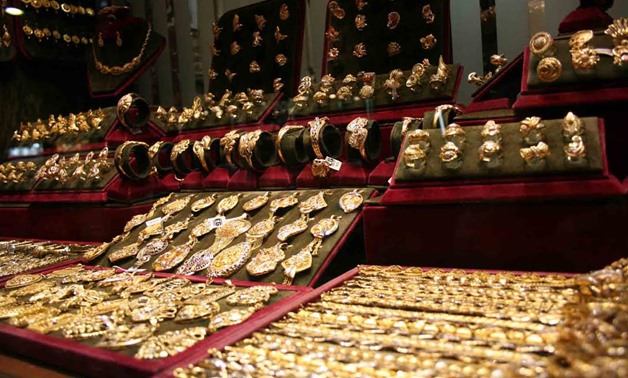
Creative Commons
CAIRO - 28 July 2017: Gold has long been a staple for Egyptians; be it for safeguarding their savings against inflation, offering brides their dowries, giving presents to parents of newborns or even Eid presents for the more privileged. But with recent market inflation after the pound’s free float, the gold market has taken a serious hit with karat prices doubling overnight.
A gram of 21-karat gold ranged between LE 634 and LE 636 late last June; almost double the LE 317 it cost in the same period last year. Similarly, the less-pure 18-karat gold has doubled from LE 271 in June 2016 to an average of LE 544 last June.
With purchasing powers and incomes taking a hit after recent economic reforms and the pound’s float, gold jewelry became out of most average Egyptians’ financial reach, causing a sharp decline in demand. Mohammed Hanafi, head of the Authority for Duties and Scales (ADS) at the Ministry of Supply and Internal Trade, explains that the local gold jewelry market lost between 50% to 60% of its clients since the currency float in November. He expects the trade volume of gold jewelry to go down from 56 tons last year to about 30 tons this year. He predicts that the local gold jewelry market will settle once the exchange rate stabilizes.
But the gold market crisis goes further back than the November currency float. Since the January 25 revolution, gold factories and workshops have either scaled down their operations or closed down altogether; going down from 4,500 to 600 factories and workshops. The remaining few have decreased their labor force by almost 70% since 2011, followed by a further 20% decrease last year after the economic reforms; going down from a total of around 400,000 workers in 2010 to 180,000 workers, according to deputy head of the gold division at the Cairo Chamber of Commerce and owner of a local gold factory Ihab Wassef. The numbers falter further when compared to the 1990s when gold trading volumes reached 300 tons; compared to the current 30 tons valued at around LE1 billion annually.
Wassef explains that in addition to the low cash liquidity and higher production costs, clients now prefer investing their money in the bank rather than buying gold jewelry after recent increases in interest rates. He adds that June marked the end-of-year exams at schools and universities, the month of Ramadan and Eid; all posing extra financial burdens on most citizens, especially middle and lower-income classes.
Rafik Abbasi, head of the gold and jewelry unit at the Metallurgical Industries chamber of the the Federation of Industries, agrees with Wassef, adding that 60% of the local gold factories and workshops are out of work due to the devaluation of the pound and increasing interest rates. “The last seven years were the worst ever,” Abbasi adds.
Egypt exports 45 tons of gold annually; 30 tons of which are in the form of items recycled from jewelry clients sell to local shops. The remaining 15 tons are in the form of raw, unrefined material extracted from Al Sukari gold mine, Abbasi says. He values gold exports at LE1.95 billion.
Driven by the gold market recession, the gold division at the Cairo Chamber of Commerce has founded a new society to organize and revive the market. “The new society will put plans to promote gold purchasing and generate new ideas to revive the gold market,” Wassef says, adding that more will be revealed about the society once it is formally launched.
In another attempt to lure more buyers, the Ministry of Supply and Internal Trade launched a new lower-karat gold jewelry last August to sell at cheaper prices; the 14-karat gold sponsored by Saudi gold jewelry manufacturer L’Azurde and sold for 20% to 22% less than the 18-karat gold. The attempt, however, wasn’t as successful as they hoped as demand remained extremely low, with pieces being light in weight, prices being higher than expected and the color of the gold not matching the most prevalent skin colors, according to a staff member at Francis Yossef jewelry store. Hisham Al Tabakh, a jewler, explains that the local culture links the value of gold to how heavy the piece is and buyers tend to prefer 18 and 21 karat gold; other options are not considered good value for money. “The commission on the gram of the 14-karat gold is so expensive, compared to what Egyptians expected when this type was introduced as it ranges between LE 100 and LE 180,” explains Al Tabah. “So the total price of the piece is not cheap enough when you compare it to the same piece in 18 karats.”
With new levels of purity failing to attract consumers back to gold, stores are trying out various marketing techniques; from monthly installments to sales during gold-purchasing seasons. Mahmoud Haiba, for instance, offers monthly installments at low interest rates on sets and pieces. “We deal with a gold manufacturer to turn 1 kg of gold to lightweight pieces and set a flat rate for all of them,” explains Haiba. “Bracelet prices do not exceed LE 750, a chain reaches LE 650, while ring prices range between LE 1, 000 to LE1, 200 per piece.” Their strategy worked; Haiba says his clients welcomed the idea and he managed to sell more than 1,000 flat-rate pieces since the beginning of June. “To celebrate Eid, we will reduce the commission per gram to LE 20 or LE 23 instead of LE 25 to attract more clients,” he adds. Other stores offer similar options, but most jewelers prefer lowering commission per gram to other promotional ideas.

Comments
Leave a Comment